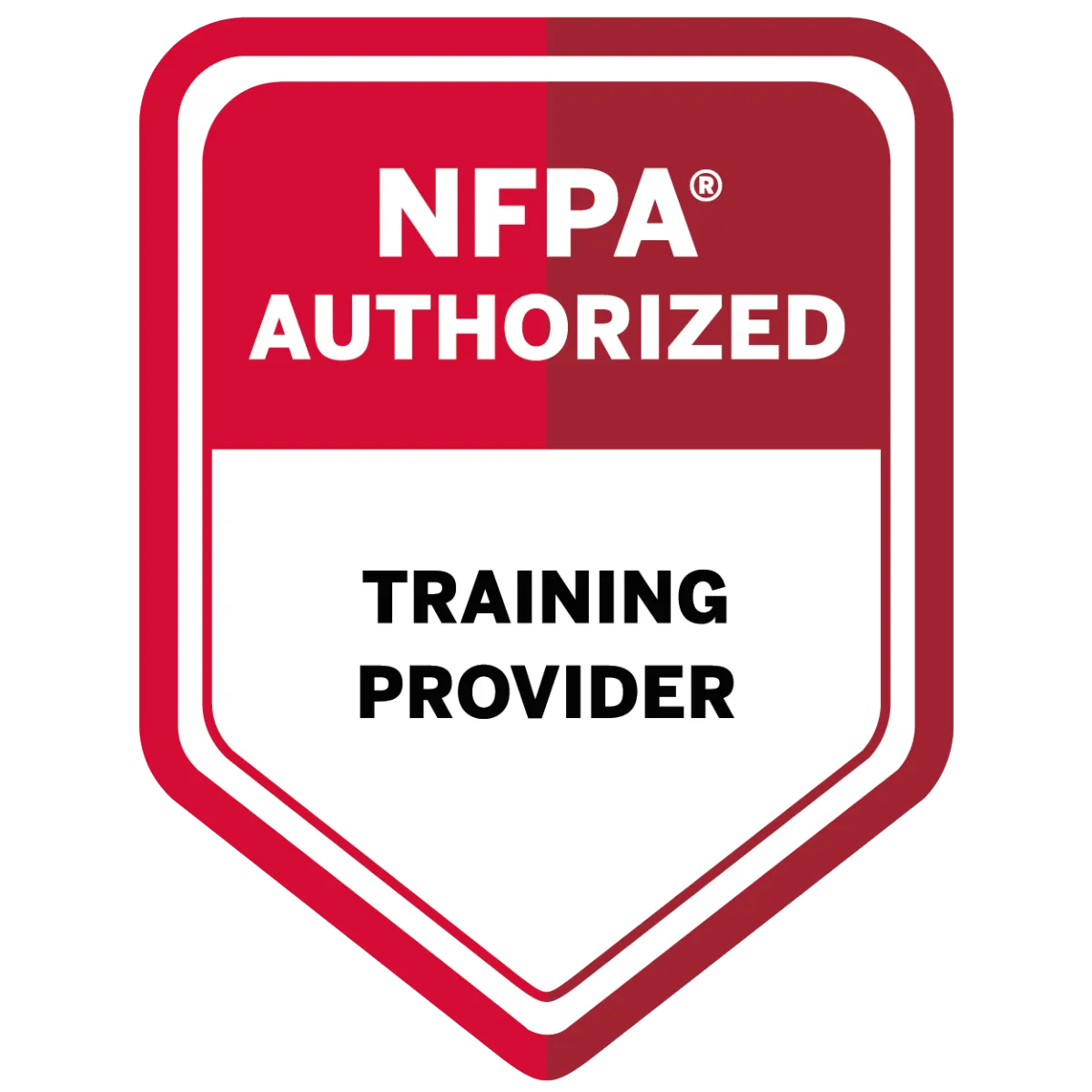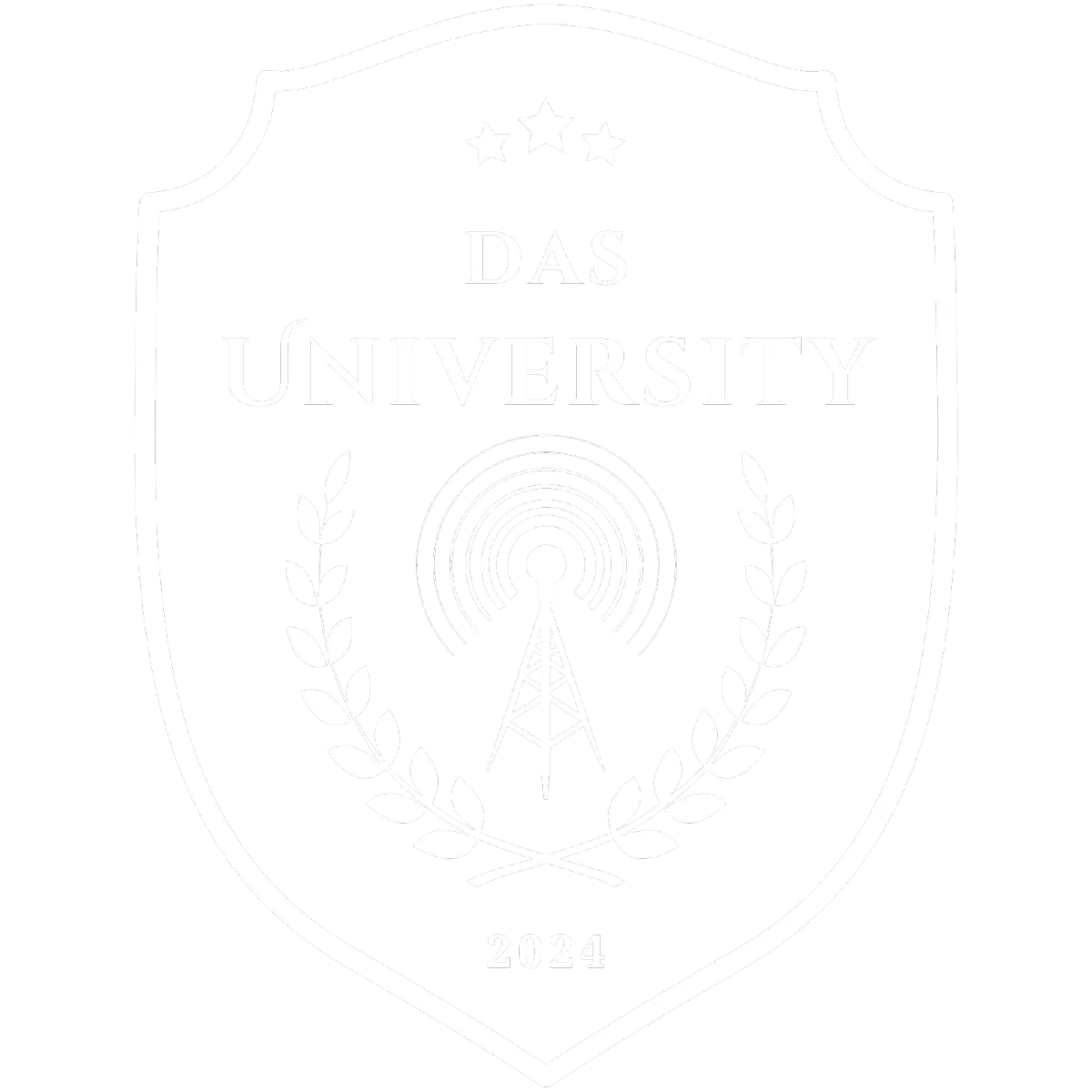WERE GOING ON TOUR!
JOIN THE DAS UNIVERSITY LIVE SUMMIT
2026 TRAINING CAMP TOUR
11 CAMPS NATION WIDE
Presented by GAMMA, BEST Ent. Mobili-fi and Industry Experts
Explore Our Unique Educational Platform
Join thousands of safety professionals, fire marshals, inspectors, integrators, and builders who are mastering the skills to install, certify, and inspect mission-critical in-building radio systems. With on-demand training, you can learn at your pace, apply it in the field, and start making buildings safer immediately.
Upgrade to our premium platform and gain the ability to earn DAS University training certificates and ICC continuing education credits for every hour of training completed. Whether you’re advancing your career, meeting code compliance requirements, or training your team, DAS University provides the recognition and real-world knowledge you need to lead with confidence.

Virtual Learning Environment
Step into our cutting-edge
virtual learning spaces, equipped with the latest tools and resources tailored for
DAS ERCES training. Experience live webinars, interactive certificate courses, and real-time collaboration with peers and instructors, ensuring an engaging and hands-on educational journey.

Professional Development
We train you on what matters: real installation standards, testing protocols, and life-saving communication system design. Our expert-led courses help you
earn DAS University training certificates, connect to job placement pipelines, and gain the confidence to lead projects with AHJs, architects, and public safety officials.

Global and Inclusive Community
Join a powerful network of safety-first professionals from across the country and around the world. With 24/7 access to our online campus, and a shared mission to protect lives, you’re never learning alone. DAS University is your community for growth, connection, and career elevation.
AUTHORIZED TRAINING PARTNERS OF THE BELOW ORGANIZATIONS

Earn CEU credits for every course on our Premium platform


About DAS University
Pioneering the Future of Education
At DAS University, we are redefining the educational landscape by integrating state-of-the-art technology with personalized learning experiences. Our mission is to empower students globally with the skills and knowledge necessary to excel in the fast-growing fields of
Distributed Antenna Systems (DAS) and Emergency Responder Communication Enhancement Systems (ERCES).
Through a blend of expert-led training courses, real-world applications
, and a supportive community, we provide an unparalleled learning journey for professionals and beginners alike.
Whether you're pursuing ERCES training, exploring advanced DAS education, or preparing for real-world challenges, we ensure you’re equipped for success. Join DAS University and transform your potential into leadership in the industry.
Achieve Training Certificates at DAS University
Elevate your professional profile with our highly regarded
DAS and ERCES training courses. Designed to provide both foundational and advanced expertise, these programs prepare you for real-world challenges in the
DAS and in-building communications industry.
Gain cutting-edge knowledge, practical skills, and DAS University training credentials to advance your career in public safety communications, emergency responder technologies, and beyond.
Hands-on project submissions
Industry-recognized guest speakers
Collaboration with 30+ industry partners
Real-time system testing simulations
Access to exclusive ERCES webinars
Unlock Your Career Potential with DAS University Training Certificates
Our DAS and ERCES training certificates document your completion—they open doors to new professional opportunities in the growing field of in-building communication systems.
Our training program participants develop practical skills for the industry, DAS University powered by Gamma is your gateway to professional growth and success. Whether you’re aiming for job placements, advanced career counseling, or building connections within a robust network of industry leaders, our programs are designed for your advancement.
Sign up now for FREE and start your journey toward professional excellence with DAS University!

Designing Effective DAS for High-Density Environments: Challenges and Solutions
High-density environments, such as stadiums, convention centers, airports, and large office buildings, pose unique challenges for wireless communication. In these settings, the sheer number of users and devices can overwhelm traditional wireless networks, leading to poor signal quality and degraded performance. Designing an effective Distributed Antenna System (DAS) for such environments requires careful planning and strategic implementation. At DAS University, we focus on educating professionals on the best practices for designing DAS in high-density settings. This blog post explores the challenges and solutions for creating effective DAS in these demanding environments.
Challenges in High-Density Environments
High User Density
Capacity Issues: The large number of users simultaneously accessing the network can cause congestion, resulting in slow data speeds and dropped connections.
Interference: High user density increases the likelihood of interference, which can degrade signal quality and reduce network performance.
Complex Building Structures
Signal Obstruction: Thick walls, floors, and other structural elements can obstruct wireless signals, creating dead zones and areas with weak coverage.
Large Coverage Areas: High-density environments often span large areas, requiring extensive infrastructure to ensure comprehensive coverage.
Diverse Use Cases
Multiple Services: High-density environments typically support a wide range of services, including voice, data, public safety communications, and IoT applications. Each service has unique requirements that must be addressed.
Peak Usage Periods: Events or peak usage periods can place additional strain on the network, necessitating a design that can handle fluctuating demand.
Regulatory Compliance
Public Safety Requirements: Ensuring compliance with public safety communication regulations is critical, especially in environments where large crowds gather.
Building Codes: Adhering to local building codes and standards is essential for the installation and operation of DAS.
Solutions for Effective DAS Design
Comprehensive Site Survey
Detailed Assessment: Conduct a thorough site survey to understand the building’s layout, user density, and specific communication needs. Identify potential interference sources and areas with weak or no coverage.
Customized Design: Use the survey data to create a customized DAS solution that addresses the unique challenges of the high-density environment.
Capacity Planning and Management
High-Capacity Antennas: Deploy high-capacity antennas that can handle large volumes of traffic. These antennas should be strategically placed to maximize coverage and minimize interference.
Sectorization: Divide the coverage area into smaller sectors, each served by its own antenna. This approach helps manage capacity more effectively and reduces the impact of interference.
Advanced Technologies
MIMO (Multiple Input Multiple Output): Implement MIMO technology to increase data throughput and improve signal quality. MIMO uses multiple antennas to transmit and receive signals, enhancing overall network performance.
Carrier Aggregation: Utilize carrier aggregation to combine multiple frequency bands, increasing bandwidth and improving data speeds for users.
Strategic Antenna Placement
Optimal Locations: Place antennas in locations that provide the best coverage and capacity, such as high-traffic areas, corners, and central locations within the building.
Minimizing Obstruction: Ensure that antennas are positioned to minimize obstruction from walls, floors, and other structural elements. Use ceiling or wall-mounted antennas to enhance coverage.
Integration with Small Cells
Hybrid Solutions: Integrate small cells with DAS to create a hybrid solution that leverages the strengths of both technologies. Small cells can be deployed in specific high-traffic areas to provide targeted capacity boosts.
Seamless Handoffs: Ensure seamless handoffs between DAS and small cells to maintain consistent connectivity and high-quality service for users.
Redundancy and Reliability
Backup Systems: Implement backup power solutions, such as batteries or generators, to ensure continuous operation during power outages. Redundant pathways can also enhance system reliability.
Resilient Design: Design the DAS with resilience in mind, ensuring that if one part of the system fails, the rest can continue to operate without interruption.
Ongoing Monitoring and Maintenance
Real-Time Monitoring: Use real-time monitoring tools to track the performance of the DAS. This allows for prompt detection and resolution of any issues, ensuring optimal performance.
Regular Maintenance: Schedule regular maintenance and testing to keep the DAS in top condition. Periodic reviews can help identify areas for improvement and ensure the system continues to meet the demands of the high-density environment.
Compliance with Regulations
Public Safety Integration: Ensure that the DAS supports public safety communications, such as police, fire, and emergency medical services. Compliance with regulations like NFPA and IFC codes is critical.
Building Code Adherence: Adhere to local building codes and standards during the installation and operation of the DAS to ensure safety and legal compliance.
Case Study: DAS Implementation in a Large Convention Center
A large convention center faced significant challenges in providing reliable wireless coverage due to its size, complex layout, and high user density during events. By conducting a comprehensive site survey and designing a customized DAS solution, the convention center was able to achieve seamless coverage and high-capacity performance. The implementation included high-capacity antennas, sectorization, MIMO technology, and integration with small cells to handle peak usage periods. Redundant pathways and backup power solutions ensured continuous operation, while real-time monitoring and regular maintenance kept the system performing optimally. The result was a robust, reliable wireless network that met the needs of both event organizers and attendees.
Conclusion
Designing an effective DAS for high-density environments requires addressing unique challenges related to user density, building structure, diverse use cases, and regulatory compliance. By employing strategies such as comprehensive site surveys, capacity planning, advanced technologies, strategic antenna placement, integration with small cells, and ongoing monitoring, it is possible to create a DAS that delivers reliable, high-quality wireless coverage. At DAS University, we are dedicated to educating professionals on the best practices for designing DAS in high-density environments, preparing them to meet the demands of these complex settings. Join us to learn more about enhancing wireless communication and become a leader in deploying advanced DAS solutions.
Hear Directly from Our Students: Real Stories, Real Success
Discover the impact of DAS University through the voices of our students. From groundbreaking education to career breakthroughs, our learners share their journeys and the transformative experiences they've encountered.

DAS University not only taught me the technical skills needed for advanced DAS systems but also how to apply them effectively in real-world scenarios. The network I’ve built through the university’s alumni connections has opened up numerous opportunities for collaboration and growth.

Raj Patel

The DAS training certificate has been beneficial for my career. The practical knowledge and hands-on training I received have allowed me to transition into a higher role within my company. The support and expert advice from faculty were invaluable.

Emily Nguyen

Enrolling at DAS University was one of the best decisions I've made for my professional development. The interactive courses and live sessions with industry experts have greatly enhanced my understanding and confidence in handling complex projects in my field.

Albert Dubois
Start Your Journey at DAS University Today
Embark on a transformative path of discovery and professional growth with our cutting-edge
DAS and ERCES training courses and a vibrant academic community. At DAS University, we provide the tools, resources, and industry connections to help you not just meet but exceed your career aspirations in the fields of
Distributed Antenna Systems (DAS) and Emergency Responder Communication Enhancement Systems (ERCES).
Whether you’re aiming to gain DAS University training certificates, explore real-world applications, or network with industry professionals, DAS University is here to turn your potential into measurable success.
Our Latest Articles

Designing Effective DAS for High-Density Environments: Challenges and Solutions
High-density environments, such as stadiums, convention centers, airports, and large office buildings, pose unique challenges for wireless communication. In these settings, the sheer number of users and devices can overwhelm traditional wireless networks, leading to poor signal quality and degraded performance. Designing an effective Distributed Antenna System (DAS) for such environments requires careful planning and strategic implementation. At DAS University, we focus on educating professionals on the best practices for designing DAS in high-density settings. This blog post explores the challenges and solutions for creating effective DAS in these demanding environments.
Challenges in High-Density Environments
High User Density
Capacity Issues: The large number of users simultaneously accessing the network can cause congestion, resulting in slow data speeds and dropped connections.
Interference: High user density increases the likelihood of interference, which can degrade signal quality and reduce network performance.
Complex Building Structures
Signal Obstruction: Thick walls, floors, and other structural elements can obstruct wireless signals, creating dead zones and areas with weak coverage.
Large Coverage Areas: High-density environments often span large areas, requiring extensive infrastructure to ensure comprehensive coverage.
Diverse Use Cases
Multiple Services: High-density environments typically support a wide range of services, including voice, data, public safety communications, and IoT applications. Each service has unique requirements that must be addressed.
Peak Usage Periods: Events or peak usage periods can place additional strain on the network, necessitating a design that can handle fluctuating demand.
Regulatory Compliance
Public Safety Requirements: Ensuring compliance with public safety communication regulations is critical, especially in environments where large crowds gather.
Building Codes: Adhering to local building codes and standards is essential for the installation and operation of DAS.
Solutions for Effective DAS Design
Comprehensive Site Survey
Detailed Assessment: Conduct a thorough site survey to understand the building’s layout, user density, and specific communication needs. Identify potential interference sources and areas with weak or no coverage.
Customized Design: Use the survey data to create a customized DAS solution that addresses the unique challenges of the high-density environment.
Capacity Planning and Management
High-Capacity Antennas: Deploy high-capacity antennas that can handle large volumes of traffic. These antennas should be strategically placed to maximize coverage and minimize interference.
Sectorization: Divide the coverage area into smaller sectors, each served by its own antenna. This approach helps manage capacity more effectively and reduces the impact of interference.
Advanced Technologies
MIMO (Multiple Input Multiple Output): Implement MIMO technology to increase data throughput and improve signal quality. MIMO uses multiple antennas to transmit and receive signals, enhancing overall network performance.
Carrier Aggregation: Utilize carrier aggregation to combine multiple frequency bands, increasing bandwidth and improving data speeds for users.
Strategic Antenna Placement
Optimal Locations: Place antennas in locations that provide the best coverage and capacity, such as high-traffic areas, corners, and central locations within the building.
Minimizing Obstruction: Ensure that antennas are positioned to minimize obstruction from walls, floors, and other structural elements. Use ceiling or wall-mounted antennas to enhance coverage.
Integration with Small Cells
Hybrid Solutions: Integrate small cells with DAS to create a hybrid solution that leverages the strengths of both technologies. Small cells can be deployed in specific high-traffic areas to provide targeted capacity boosts.
Seamless Handoffs: Ensure seamless handoffs between DAS and small cells to maintain consistent connectivity and high-quality service for users.
Redundancy and Reliability
Backup Systems: Implement backup power solutions, such as batteries or generators, to ensure continuous operation during power outages. Redundant pathways can also enhance system reliability.
Resilient Design: Design the DAS with resilience in mind, ensuring that if one part of the system fails, the rest can continue to operate without interruption.
Ongoing Monitoring and Maintenance
Real-Time Monitoring: Use real-time monitoring tools to track the performance of the DAS. This allows for prompt detection and resolution of any issues, ensuring optimal performance.
Regular Maintenance: Schedule regular maintenance and testing to keep the DAS in top condition. Periodic reviews can help identify areas for improvement and ensure the system continues to meet the demands of the high-density environment.
Compliance with Regulations
Public Safety Integration: Ensure that the DAS supports public safety communications, such as police, fire, and emergency medical services. Compliance with regulations like NFPA and IFC codes is critical.
Building Code Adherence: Adhere to local building codes and standards during the installation and operation of the DAS to ensure safety and legal compliance.
Case Study: DAS Implementation in a Large Convention Center
A large convention center faced significant challenges in providing reliable wireless coverage due to its size, complex layout, and high user density during events. By conducting a comprehensive site survey and designing a customized DAS solution, the convention center was able to achieve seamless coverage and high-capacity performance. The implementation included high-capacity antennas, sectorization, MIMO technology, and integration with small cells to handle peak usage periods. Redundant pathways and backup power solutions ensured continuous operation, while real-time monitoring and regular maintenance kept the system performing optimally. The result was a robust, reliable wireless network that met the needs of both event organizers and attendees.
Conclusion
Designing an effective DAS for high-density environments requires addressing unique challenges related to user density, building structure, diverse use cases, and regulatory compliance. By employing strategies such as comprehensive site surveys, capacity planning, advanced technologies, strategic antenna placement, integration with small cells, and ongoing monitoring, it is possible to create a DAS that delivers reliable, high-quality wireless coverage. At DAS University, we are dedicated to educating professionals on the best practices for designing DAS in high-density environments, preparing them to meet the demands of these complex settings. Join us to learn more about enhancing wireless communication and become a leader in deploying advanced DAS solutions.
Frequently Asked Questions
What makes DAS University different from traditional educational institutions?
DAS University combines expert-led courses, dynamic online interactions, and live events to create a comprehensive and interactive learning experience that goes beyond traditional classroom boundaries.
How does the subscription model work at DAS University?
Our subscription model offers unlimited access to all courses and resources on the platform, allowing students to learn at their own pace and according to their own schedules. Enjoy a FREE version and premium version
What types of courses does DAS University offer?
We offer a wide range of courses focused on Distributed Antenna Systems (DAS), including basics of radio frequency, system design, and emergency responder communication enhancement systems, among others.
Can I interact directly with instructors and guest speakers?
Yes, our platform includes real-time chat, discussion forums, and weekly live Zoom sessions where students can engage directly with instructors and industry experts.
What are the career opportunities after completing courses at DAS University?
Completing courses at DAS University can lead to various roles in the DAS industry, such as system integrator, radio technician, and various positions in emergency response, depending on the course.
How do I access the digital library?
The digital library is available through the Campus portal, where students can access research papers, case studies, e-books, and multimedia resources related to their courses.
What is included in the certification from DAS University?
Training certificates include your name, course title, completion date, unique certificate number, and document your completion of DAS University training programs
How can I participate in special interest groups and clubs?
Students can join various groups and clubs through the Campus portal, allowing them to connect with peers who share similar interests and professional goals. Premium Version only
Are there resources for hands-on learning in DAS University courses?
Yes, we provide simulation tools and virtual labs for hands-on experience, as well as gamified learning modules to make complex concepts more engaging. Only available in the Premium version.
What support is available if I encounter difficulties in my coursework?
The Feedback and Support Center offers direct access to faculty and technical support to assist with any course-related inquiries.
How does DAS University accommodate international students?
We offer 24/7 campus access and multilingual support to ensure that students from all time zones and linguistic backgrounds can fully participate.
What is the process for obtaining certification at DAS University?
To obtain a training certificate, students must complete all modules, pass the final assessment with a required minimum score, and actively participate in live sessions and forums. Only available in the Premium version.
Can I share my certification on professional networks?
Yes, upon completion, students receive both a physical training certificate and a digital badge that can be shared on LinkedIn and other professional networks. Only available in the Premium version.
What are the live webinar auditoriums used for?
The auditoriums host weekly live sessions with guest speakers and industry pofessionals, featuring interactive Q&A sessions and panel discussions.
What tools are available for career development at DAS University?
Our Career Center provides career counseling, resume workshops, job postings, and an alumni network for mentorship and professional connections. Only available in the Premium version.
How can I track my course progress and assessments?
The Certification Portal on our platform allows students to track their progress, assessments, and training certificate status.
What kind of assessments are used in DAS University courses?
Assessments include quizzes, assignments, project submissions, and a final examination to comprehensively test understanding and practical application.
How can I continue learning after completing my courses?
Certificate holders are encouraged to participate in advanced courses, seminars, and periodic refresher courses to keep their knowledge current.
Are there opportunities for networking within the DAS University community?
Yes, training certificate completion grants access to an alumni network, facilitating peer interactions, knowledge sharing, and networking opportunities. Only available in the Premium version.
How do I provide feedback on my learning experience?
Students can provide feedback through forums in the Feedback and Support Center, helping us to continually improve the campus experience.


